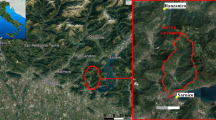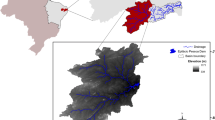Abstract
Verification of soil erosion models (WATEM/SEDEM for rainfall and tillage soil erosion and regional model of the State Hydrological Institute for snowmelt soil erosion) was carried out on the basis of estimates of soil erosion and deposition rates in an arable catchment of dry valley in the Vorobzha River basin located in the central part of the Srednerusskaya Upland in the forest-steppe zone. The rates of soil loss/gain for the entire period of agricultural use were obtained using the soil truncation method. The rate of sediment deposition in the dry valley bottom for the period after the 1986 was determined based on interpretation the Chernobyl-derived 137Cs depth distribution in the sediments. Comparison of the model calculations with field-based method estimates was generally in good agreement. Also, the erosion model calculation satisfactorily reflected the pattern of zones with different intensity of soil erosion. WATEM/SEDEM made it possible to take into account the movement of soil matter by tillage erosion. Some discrepancies between the modeling results and field data were mainly due to the insufficiently detailed input parameters, e.g., the data on crop rotations or local microrelief specifics. WATEM/SEDEM did not accurately estimate the rate and volume of sediment accumulation, especially for areas beyond cropland.





Similar content being viewed by others
REFERENCES
V. V. Antonov, “The use of hydraulic structures in anti-erosion forest reclamation,” Lesn. Khoz., No. 9, 31–33 (1991).
A. T. Barabanov, S. V. Dolgov, N. I. Koronkevich, V. I. Panov, and A. I. Petel’ko, “Surface runoff and snowmelt infiltration into the soil on plowlands in the forest-steppe and steppe zones of the East European plain,” Eurasian Soil Sci. 51 (1), 66–72 (2018). https://doi.org/10.1134/S1064229318010039
D. A. Bezukhov, V. N. Golosov, and A. V. Panin, “Estimation of the coefficient of sediment delivery from small watersheds in the forest-steppe and steppe regions of the East European Plain,” Izv. Ross. Akad. Nauk, Ser. Geogr., No. 4, 73–84 (2019). https://doi.org/10.31857/S2587-55662019473-84
V. N. Golosov, Erosion-Accumulation Processes in the River Basins of Developed Plains (GEOS, Moscow, 2006) [in Russian].
A. P. Zhidkin, V. N. Golosov, and A. S. Dobryanskii, “Evaluation of the applicability of digital elevation models for modeling soil erosion (on the example of a small catchment area in the Kursk region),” Sovrem. Probl. Distantsionnogo Zondirovaniya Zemli Kosmosa 18 (5), 133–144 (2021). https://doi.org/10.21046/2070-7401-2021-18-5-133-144
D. N. Kozlov, A. P. Zhidkin, and N. I. Lozbenev, “Digital mapping of erosive soil cover structures based on a simulation model of washout (northern forest-steppe of the Central Russian Upland),” Byull. Pochv. Inst. im. V. V. Dokuchaeva, No. 100, 5–29 (2019). https://doi.org/10.19047/0136-1694-2019-100-5-35
M. V. Kumani, Abstract of Doctoral Dissertation in Agriculture (Kursk, 2003).
G. A. Larionov, Erosion and Deflation of Soils: Main Regularities and Quantitative Estimates (Mosk. Univ., Moscow, 1993) [in Russian].
G. A. Larionov, S. F. Krasnov, L. F. Litvin, N. G. Dobrovol’skaya, and Z. P. Kiryukhina, “Empirical (statistical) model of soil erosion,” in Erosion-Channel Systems (Moscow, 2017), pp. 154–173 [in Russian].
F. N. Liseatskii, A. A. Svetlichnyi, and S. G. Chernyi, Modern Problems of Erosion Studies (Konstanta, Belgorod, 2012) [in Russian].
L. F. Litvin, Geography of Soil Erosion of Agricultural Lands in Russia (IKTs Akademkniga, Moscow, 2002) [in Russian].
L. F. Litvin, Z. P. Kiryukhina, S. F. Krasnov, and N. G. Dobrovol’skaya, “Dynamics of agricultural soil erosion in European Russia,” Eurasian Soil Sci. 50 (11), 1344–1353 (2017). https://doi.org/10.1134/S1064229317110084
L. F. Litvin, Z. P. Kiryukhina, S. F. Krasnov, N. G. Dobrovol’skaya, and A. V. Gorobets, “Dynamics of agricultural soil erosion in Siberia and Far East,” Eurasian Soil Sci. 54 (1), 150–160 (2021). https://doi.org/10.1134/S1064229321010075
K. A. Maltsev and O. P. Yermolaev, “Potential soil loss from erosion on arable lands in the European part of Russia,” Eurasian Soil Sci. 52 (12), 1588–1597 (2019). https://doi.org/10.1134/S106422931912010X
Guidelines for Compiling Large-Scale Maps of Erosion-Hazardous Lands to Justify Soil Protection Measures in On-Farm Land Management (Mosk. Univ., Moscow, 1996) [in Russian].
All-Union Instruction on Soil Surveys and Compilation of Large-Scale Soil Maps of Land Use (Kolos, Moscow, 1973) [in Russian].
Z. V. Patsukevich, A. N. Gennadiev, and M. I. Gerasimova, “Permissible washout and self-healing of soils,” Pochvovedenie, No. 5, 634–641 (1997).
Weather in Artel’noe, Belgorod oblast. https://rp5.ru/. Cited November 1, 2021.
G. P. Surmach, Relief Formation, Formation of the Forest-Steppe, Modern Erosion and Anti-Erosion Measures (Volgograd, 1992) [in Russian].
Erosion-Channel Systems (INFRA-M, Moscow, 2017) [in Russian].
L. C. Alatorre, S. Beguería, and J. M. García-Ruiza, “Regional scale modeling of hillslope sediment delivery: a case study in the Barasona Reservoir watershed (Spain) using WATEM/SEDEM,” J. Hydrol. 391, 109–123 (2010). https://doi.org/10.1016/j.jhydrol.2010.07.010
C. Alewell, P. Borrelli, K. Meusburger, and P. Panagos, “Using the USLE: chances, challenges and limitations of soil erosion modelling,” Int. Soil Water Conserv. Res. 7, 203–225 (2019). https://doi.org/10.1016/j.iswcr.2019.05.004
P. V. G. Batista, J. Davies, M. L. N. Silva, and J. N. Quinton, “On the evaluation of soil erosion models: Are we doing enough?” Earth-Sci. Rev. 197, (2019). https://doi.org/10.1016/j.earscirev.2019.102898
V. R. Belyaev, V. N. Golosov, A. Yu. Sidorchuk, P. J. Wallbrink, and A. S. A. Murray, “A comparison of methods for evaluating soil redistribution in the severely eroded Stavropol region, southern European Russia,” Geomorphology 65 (3–4), 173–193 (2005). https://doi.org/10.1016/j.geomorph.2004.09.001
D. A. Borrelli, L. R. Robinson, E. Fleischer, C. Lugato, C. Ballabio, K. Alewell, S. Meusburger, et al., “An assessment of the global impact of 21st century land use change on soil erosion,” Nat. Commun. 8 (1) art. 2013 (2017). https://doi.org/10.1038/s41467-017-02142-7
J. de Vente, J. Poesen, G. Verstraeten, G. Govers, M. Vanmaercke, A. Van Rompaey, M. Arabkhedri, and C. Boix-Fayos, “Predicting soil erosion and sediment yield at regional scales: where do we stand?” Earth Sci. Rev. 127, 16–29 (2013). https://doi.org/10.1016/j.earscirev.2014.03.002
V. N. Golosov, A. L. Collins, N. G. Dobrovolskaya, O. I. Bazhenova, Yu. V. Ryzhov, and A. Yu. Sidorchuk, “Soil loss on the arable lands of the forest-steppe and steppe zones of European Russia and Siberia during the period of intensive,” Geoderma 381, (2021). https://doi.org/10.1016/j.geoderma.2020.114678
V. N. Golosov, N. N. Ivanova, A. V. Gusarov, and A. G. Sharifullin, “Assessment of the trend of degradation of arable soils on the basis of data on the rate of stratozem development obtained with the use of 137Cs as a Chronomarker,” Eurasian Soil Sci. 50 (10), 1195–1208 (2017). https://doi.org/10.1134/S1064229317100039
V. Golosov, A. Koiter, M. Ivanov, K. Maltsev, A. Gusarov, A. Sharifullin, and I. Radchenko, “Assessment of soil erosion rate trends in two agricultural regions of European Russia for the last 60 years,” J. Soils Sediments 18 (12), 3388–3403 (2018c). https://doi.org/10.1007/s11368-018-2032-1
V. N. Golosov, D. E. Walling, A. V. Konoplev, M. M. Ivanov, and A. G. Sharifullin, “Application of bomb- and Chernobyl-derived radiocaesium for reconstructing changes in erosion rates and sediment fluxes from croplands in areas of European Russia with different levels of Chernobyl fallout,” J. Environ. Radioact. 186, 78–89 (2018b). https://doi.org/10.1016/j.jenvrad.2017.06.022
V. Golosov, O. Yermolaev, L. Litvin, N. Chizhikova, Z. Kiryukhina, and G. Safina, “Influence of climate and land use changes on recent trends of soil erosion rates within the Russian Plain,” Land Degrad. Dev. 29 (8), 2658–2667 (2018). https://doi.org/10.1002/ldr.3061
N. Haregeweyn, J. Poesen, G. Verstraeten, G. Govers, J. de Vente, J. Nyssen, J. Deckers, and J. Moeyersons, “Assessing the performance of a spatially distributed soil erosion and sediment delivery model (WATEM/SEDEM) in Northern Ethiopia,” Land Degrad. Dev. 24, 188–204 (2013). https://doi.org/10.1002/ldr.1121
C. G. Karydas, P. Panagos, and I. Z. Gitas, “A classification of water erosion models according to their geospatial characteristics,” Int. J. Digital Earth. 7 (3), 229–250 (2012). https://doi.org/10.1080/17538947.2012.671380
N. Khitrov, M. Smirnova, N. Lozbenev, E. Levchenko, V. Gribov, D. Kozlov, D. Rukhovich, N. Kalinina, and P. Koroleva, “Soil cover patterns in the forest-steppe and steppe zones of the east-european plain,” Soil Sci. Annu. 70 (3), 198–210 (2019). https://doi.org/10.2478/ssa-2019-0018
J. Krasa, T. Dostál, K. Vrana, and J. Plocek, “Predicting spatial patterns of sediment delivery and impacts of land-use scenarios on sediment transport in Czech catchments,” Land Degrad. Dev. 2, 367–375 (2010). https://doi.org/10.1002/ldr.959
R. Lal, “Soil erosion by wind and water: problems and prospects,” in Soil Erosion Research Methods. Soil and Water Conservation Society, Ed. by R. Lal (St. Lucie Press, America, 1994), pp. 1–9. https://doi.org/10.1201/9780203739358-1
J. Lieskovský and P. Kenderessy, “Modelling the effect of vegetation cover and different tillage practices on soil erosion in vineyards: a case study in vráble (Slovakia) using WATEM/SEDEM,” Land Degrad. Dev. 25 (3), 288–296 (2014). https://doi.org/10.1002/ldr.2162
D. A. Lobb, R. G. Kachanoski, and M. H. Miller, “Tillage translocation and tillage erosion on shoulder slope landscape positions measured using 137Cs as a tracer,” Can. J. Soil Sci. 75, 211–218 (1995). https://doi.org/10.4141/cjss95-029
N. Lozbenev, A. Yurova, M. Smirnova, and D. Kozlov, “Incorporating process-based modeling into digital soil mapping: a case study in the virgin steppe of the Central Russian upland,” Geoderma 383, (2021). https://doi.org/10.1016/j.geoderma.2020.114733
P. Panagos, P. Borrelli, K. Meusburger, et al., “Global rainfall erosivity assessment based on high-temporal resolution rainfall records,” Sci. Rep. 7 (1), art. 4175 (2017). https://doi.org/10.1038/s41598-017-04282-8
A. Pandey, S. K. Himanshu, S. K. Mishra, and V. P. Singh, “Physically based soil erosion and sediment yield models revisited,” Catena 147, 595–620 (2016). https://doi.org/10.1016/J.CATENA.2016.08.002
A. V. Panin, D. E. Walling, and V. N. Golosov, “The role of soil erosion and fluvial processes in the post-fallout redistribution of chernobyl-derived caesium-137: a case study of the Lipki catchment, Central Russia,” Geomorphology 40 (3–4), 185–204 (2001). https://doi.org/10.1016/S0169-555X(01)00043-5
J. Pietroń, S. R. Chalov, A. S. Chalova, A. V. Alekseenko, and J. Jarsjö, “Extreme spatial variability in riverine sediment load inputs due to soil loss in surface mining areas of the Lake Baikal basin,” Catena 152, 82–93 (2017). https://doi.org/10.1016/j.catena.2017.01.008
F. F. Pruski and M. A. Nearing, “Climate-induced changes in erosion during the 21st century for eight U.S. locations,” Water Resour. Res. 38 (12), 34-1–34-11 (2002). https://doi.org/10.1029/2001WR000493
Sediment Transport Using WaTEM/SEDEM. https:// esdac.jrc.ec.europa.eu/themes/sediment-transport-using-watemsedem. Cited November 10, 2021.
P. Tsymbarovich, G. Kust, M. Kumani, V. Golosov, and O. Andreeva, “Soil erosion: an important indicator for the assessment of land degradation neutrality in Russia,” Int. Soil Water Conserv. Res. 8 (4), 418–429 (2020). https://doi.org/10.1016/j.iswcr.2020.06.002
M. Van Loo, B. Dusara, G. Verstraetena, H. Renssen, B. Notebaert, K. D’Haen, and J. Bakker, “Human induced soil erosion and the implications on crop yield in a small mountainous Mediterranean catchment (SW-Turkey),” Catena 149, 491–504 (2017). https://doi.org/10.1016/j.catena.2016.08.023
K. Van Oost, O. Cerdan, and T. A. Quine, “Accelerated fluxes by water and tillage erosion on European agricultural land,” Earth Surf. Processes Landforms. 34, 1625–1634 (2009). https://doi.org/10.1002/esp.1852
K. Van Oost, G. Govers, and P. Desmet, “Evaluating the effects of changes in landscape structure on soil erosion by water and tillage,” Landscape Ecol. 15, 577–589 (2000). https://doi.org/10.1023/A:1008198215674
A. Van Rompay, G. Verstraeten, K. Van Oost, G. Govers, and J. Poesen, “Modelling mean annual sediment yield using a distributed approach,” Earth Surf. Processes Landforms 26 (11), 1221–1236 (2001). https://doi.org/10.1002/esp.275
G. Verstraeten, I. P. Prosser, and P. Fogarty, “Predicting the spatial patterns of hillslope sediment delivery to river channels in the Murrumbidgee catchment, Australia,” J. Hydrol. 334, 440–454 (2007).https://doi.org/10.1016/j.jhydrol.2006.10.025
A. Zhidkin, D. Fomicheva, N. Ivanova, T. Dostál, A. Yurova, M. Komissarov, and J. Krása, “A detailed reconstruction of changes in the factors and parameters of soil erosion over the past 250 years in the forest zone of European Russia (Moscow region),” Int. Soil Water Conserv. Res. 10, 149–160 (2022). https://doi.org/10.1016/j.iswcr.2021.06.003
Funding
This study was supported financially by the Russian Foundation for Basic Research, project no. 19-29-05025mk (field research: assessment of the sedimentation rate in the dry valley bottom with radiocesium method and the use of the soil profile truncation method); as well as by the Russian Science Foundation, project no. 22-17-00071 (digital modeling of erosion-accumulation processes and verification of models).
Author information
Authors and Affiliations
Corresponding author
Ethics declarations
The authors declare that they have no conflicts of interest.
Additional information
Translated by O. Eremina
Supplementary Information
Rights and permissions
About this article
Cite this article
Golosov, V.N., Zhidkin, A.P., Petel’ko, A.I. et al. Field Verification of Erosion Models Based on the Studies of a Small Catchment in the Vorobzha River Basin (Kursk oblast, Russia). Eurasian Soil Sc. 55, 1508–1523 (2022). https://doi.org/10.1134/S1064229322100040
Received:
Revised:
Accepted:
Published:
Issue Date:
DOI: https://doi.org/10.1134/S1064229322100040




